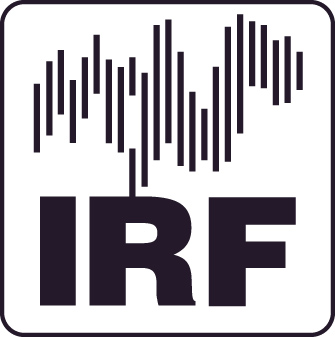
Esrange MST radar (ESRAD)
Esrange MST radar
Esrange MST radar

The Esrange MST (Mesosphere-Stratosphere-Troposphere) radar ESRAD is an atmospheric radar located at Esrange, just outside
Kiruna in northern Sweden. It began operations in July 1996. The purpose of the radar is to provide information on the
dynamic state of the atmosphere - winds, waves, turbulence and layering, from the troposphere up to the mesopause (ca. 1-90 km altitude).
The main investment costs for the radar were shared by SSC Esrange and the Swedish Natural Science Research Council (by way of a grant to the Swedish Institute of Space Physics in Kiruna). The transmitter and receiver hardware have been constructed under contract by Atmospheric Radar Systems Pty Ltd (ATRAD) of Adelaide, Australia. In 2004 and again in December 2015 ESRAD was upgraded under contract with Genesis Software Pty, Australia. The antenna installation, necessary infrastructure, the management of the hardware installation and the hardware maintenance have been taken care of by SSC (Esrange). Scientific data analysis and distribution, plus some further investment costs, are being provided by the Swedish Institute of Space Physics.
The antenna array
The original antenna array was installed at the radar site during autumn 1995. The antenna comprised a 12x12 array of 5-element yagis, each ca. 6 m high 3 m across. The yagis are spaced about 4 m apart (corresponding to 0.7 times the radar wavelength). The 4 central positions in the array are not filled so as to allow for a small hut, containing the transmitters, receivers and control computer, to be located at the centre of the array. Each group of 4 nearest-neighbour yagis is separately connected to the control house. This will allow a large number of different antenna configurations using a patch board in the control house. It also gave the possibility for phase-steering of the beam to off zenith directions. In 2004 the array was expanded to 16x18 5-element yagis and the phase-steering option was removed. The 1-way half-power-width of the main lobe of this antenna is about 5 °. In 2015 a small remote receive-only array (3 sub-arrays of 4 yagis each) was constructed about 30 m away from the south-east corner of the main array. In combination with transmitting on only part of the main array, this allows measurements at the lowest altitudes starting at about 0.5 km.

The positions of the antenna elements and the antenna response pattern for the 12x12 array
The transmitter and receiver
The original receiver and transmitter hardware have been constructed under contract by ATRAD. The transmitter frequency is 52 MHz and 72 kW peak transmitter power is available with at most a 5% duty cycle. Pulse repetition rates from 100 Hz to 16 kHz and pulse lengths corresponding to height resolutions between 75 m and 3 km are possible. In 2015, the old receivers were replaced by new ones from Genesis Sofware Pty.
The radar transmits vertically with the whole main antenna array, but for reception it is divided into 12 segments (6 segments until December 2015), each connected to separate receiver. Additionally, there are 3 remote receivers (since December 2015). The receivers have 1 MHz bandwidth and separate detection of in-phase and quadrature components. This allows post-detection beam-steering and full spectral analysis of the returned signal. The digital processing system has sampling rates corresponding to the height resolutions above, can process up to 256 heights per sample and integrate up to 4096 pulse repetitions per sample.
Software
Basic software for radar control and data acquisition as well as our own software for analysis runs in real-time. Vertical wind is derived from the Doppler shift of the return signal by combining all receivers. Horizontal winds and other atmospheric parameters are derived from time delays between signals arriving at different sub-arrays using full correlation analysis as described by D. Holdsworth, 1995.
Operations
As mentioned above, the technical specifications of the receivers allow heights from 100 m -128 km to be sampled. However, due to the properties of the atmosphere, useable echoes are not expected from all heights. Wind measurements are obtained for heights ca. 0.5-12 km (ca. 15 km with pulse coding) and close to the mesopause, i.e. 80-90 km, in summer. In addition is possible to study the morphology of the tropopause at ca. 8-12 km height, inertial gravity waves up to ca. 20 km, and other distinct echo structures such as PMSE (polar mesosphere summer echoes) at ca. 85 km and layers between 50 and 80 km which sometimes can be seen in winter. The background noise level can also be used as a monitor of cosmic noise absorption to detect the effects of energetic particle precipitation.
The radar runs continuously, cycling between modes optimized for lower troposphere troposphere/stratosphere, or mesosphere. A typical cycle measures for 1-2 minutes in each mode, repeating every 2-3 minutes. Special cycles, concentrating on one atmospheric region may be run from time to time, for example in support of rocket or balloon campaigns at Esrange. Real-time winds are available to experimenters at Esrange, and via internet to other users. The data archive is available to interested scientists on a cooperative basis.
Scientific applications
Studies of the troposphere, lower stratosphere and mesosphere using the radar are being carried out by the
Polar Atmospheric Research Programme at IRF-K.
For further information contact Evgenia Belova, evgenia.belova*irf.se
Updated 2011-10-29, webmaster*irf.se



